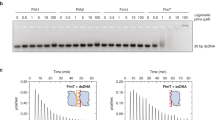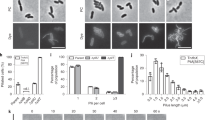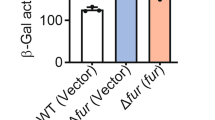Abstract
Natural transformation is a broadly conserved mechanism of horizontal gene transfer in bacterial species that can shape evolution and foster the spread of antibiotic resistance determinants, promote antigenic variation and lead to the acquisition of novel virulence factors. Surface appendages called competence pili promote DNA uptake during the first step of natural transformation1; however, their mechanism of action has remained unclear owing to an absence of methods to visualize these structures in live cells. Here, using the model naturally transformable species Vibrio cholerae and a pilus-labelling method, we define the mechanism for type IV competence pilus-mediated DNA uptake during natural transformation. First, we show that type IV competence pili bind to extracellular double-stranded DNA via their tip and demonstrate that this binding is critical for DNA uptake. Next, we show that type IV competence pili are dynamic structures and that pilus retraction brings tip-bound DNA to the cell surface. Finally, we show that pilus retraction is spatiotemporally coupled to DNA internalization and that sterically obstructing pilus retraction prevents DNA uptake. Together, these results indicate that type IV competence pili directly bind to DNA via their tip and mediate DNA internalization through retraction during this conserved mechanism of horizontal gene transfer.
This is a preview of subscription content, access via your institution
Access options
Access Nature and 54 other Nature Portfolio journals
Get Nature+, our best-value online-access subscription
$29.99 / 30 days
cancel any time
Subscribe to this journal
Receive 12 digital issues and online access to articles
$119.00 per year
only $9.92 per issue
Buy this article
- Purchase on Springer Link
- Instant access to full article PDF
Prices may be subject to local taxes which are calculated during checkout




Similar content being viewed by others
References
Chen, I. & Dubnau, D. DNA uptake during bacterial transformation. Nat. Rev. Microbiol. 2, 241–249 (2004).
Hepp, C. & Maier, B. Kinetics of DNA uptake during transformation provide evidence for a translocation ratchet mechanism. Proc. Natl Acad. Sci. USA 113, 12467–12472 (2016).
Muschiol, S., Balaban, M., Normark, S. & Henriques-Normark, B. Uptake of extracellular DNA: competence induced pili in natural transformation of Streptococcus pneumoniae. Bioessays 37, 426–435 (2015).
Graupner, S., Weger, N., Sohni, M. & Wackernagel, W. Requirement of novel competence genes pilT and pilU of Pseudomonas stutzeri for natural transformation and suppression of pilT deficiency by a hexahistidine tag on the type IV pilus protein PilAI. J. Bacteriol. 183, 4694–4701 (2001).
Laurenceau, R. et al. A type IV pilus mediates DNA binding during natural transformation in Streptococcus pneumoniae. PLoS Pathog. 9, e1003473 (2013).
Meibom, K. L., Blokesch, M., Dolganov, N. A., Wu, C. Y. & Schoolnik, G. K. Chitin induces natural competence in Vibrio cholerae. Science 310, 1824–1827 (2005).
Seitz, P. & Blokesch, M. DNA-uptake machinery of naturally competent Vibrio cholerae. Proc. Natl Acad. Sci. USA 110, 17987–17992 (2013).
Ellison, C. K. et al. Obstruction of pilus retraction stimulates bacterial surface sensing. Science 358, 535–538 (2017).
Hepp, C., Gangel, H., Henseler, K., Gunther, N. & Maier, B. Single-stranded DNA uptake during gonococcal transformation. J. Bacteriol. 198, 2515–2523 (2016).
Duffin, P. M. & Seifert, H. S. Genetic transformation of Neisseria gonorrhoeae shows a strand preference. FEMS Microbiol. Lett. 334, 44–48 (2012).
Assalkhou, R. et al. The outer membrane secretin PilQ from Neisseria meningitidis binds DNA. Microbiology 153, 1593–1603 (2007).
Burkhardt, J., Vonck, J. & Averhoff, B. Structure and function of PilQ, a secretin of the DNA transporter from the thermophilic bacterium Thermus thermophilus HB27. J. Biol. Chem. 286, 9977–9984 (2011).
Ng, D. et al. The Vibrio cholerae minor pilin TcpB initiates assembly and retraction of the toxin-coregulated pilus. PLoS Pathog. 12, e1006109 (2016).
Nguyen, Y. et al. Pseudomonas aeruginosa minor pilins prime type IVa pilus assembly and promote surface display of the PilY1 adhesin. J. Biol. Chem. 290, 601–611 (2015).
Suckow, G., Seitz, P. & Blokesch, M. Quorum sensing contributes to natural transformation of Vibrio cholerae in a species-specific manner. J. Bacteriol. 193, 4914–4924 (2011).
Gangel, H. et al. Concerted spatio-temporal dynamics of imported DNA and ComE DNA uptake protein during gonococcal transformation. PLoS Pathog. 10, e1004043 (2014).
Seitz, P. et al. ComEA is essential for the transfer of external DNA into the periplasm in naturally transformable Vibrio cholerae cells. PLoS Genet. 10, e1004066 (2014).
Borgeaud, S., Metzger, L. C., Scrignari, T. & Blokesch, M. The type VI secretion system of Vibrio cholerae fosters horizontal gene transfer. Science 347, 63–67 (2015).
Watnick, P. I. & Kolter, R. Steps in the development of a Vibrio cholerae El Tor biofilm. Mol. Microbiol. 34, 586–595 (1999).
Dietrich, M., Mollenkopf, H., So, M. & Friedrich, A. Pilin regulation in the pilT mutant of Neisseria gonorrhoeae strain MS11. FEMS Microbiol. Lett. 296, 248–256 (2009).
Hepp, C. & Maier, B. Bacterial translocation ratchets: shared physical principles with different molecular implementations: how bacterial secretion systems bias Brownian motion for efficient translocation of macromolecules. Bioessays 39, e201700099 (2017).
Burrows, L. L. Pseudomonas aeruginosa twitching motility: type IV pili in action. Annu. Rev. Microbiol. 66, 493–520 (2012).
Craig, L., Pique, M. E. & Tainer, J. A. Type IV pilus structure and bacterial pathogenicity. Nat. Rev. Microbiol. 2, 363–378 (2004).
Chang, Y. W. et al. Architecture of the type IVa pilus machine. Science 351, aad2001 (2016).
Gold, V. A., Salzer, R., Averhoff, B. & Kuhlbrandt, W. Structure of a type IV pilus machinery in the open and closed state. eLife 4, e07380 (2015).
Biais, N., Higashi, D., So, M. & Ladoux, B. Techniques to measure pilus retraction forces. Methods Mol. Biol. 799, 197–216 (2012).
Cehovin, A. et al. Specific DNA recognition mediated by a type IV pilin. Proc. Natl Acad. Sci. USA 110, 3065–3070 (2013).
Berry, J. L. et al. A comparative structure/function analysis of two type IV pilin DNA receptors defines a novel mode of DNA binding. Structure 24, 926–934 (2016).
Skerker, J. M. & Berg, H. C. Direct observation of extension and retraction of type IV pili. Proc. Natl Acad. Sci. USA 98, 6901–6904 (2001).
Maier, B. et al. Single pilus motor forces exceed 100 pN. Proc. Natl Acad. Sci. USA 99, 16012–16017 (2002).
Miller, V. L., DiRita, V. J. & Mekalanos, J. J. Identification of toxS, a regulatory gene whose product enhances ToxR-mediated activation of the cholera toxin promoter. J. Bacteriol. 171, 1288–1293 (1989).
Dalia, A. B., Lazinski, D. W. & Camilli, A. Identification of a membrane-bound transcriptional regulator that links chitin and natural competence in Vibrio cholerae. mBio 5, e01028-13 (2014).
Lo Scrudato, M. & Blokesch, M. The regulatory network of natural competence and transformation of Vibrio cholerae. PLoS Genet. 8, e1002778 (2012).
Lo Scrudato, M. & Blokesch, M. A transcriptional regulator linking quorum sensing and chitin induction to render Vibrio cholerae naturally transformable. Nucleic Acids Res. 41, 3644–3658 (2013).
Dalia, A. B., McDonough, E. & Camilli, A. Multiplex genome editing by natural transformation. Proc. Natl Acad. Sci. USA 111, 8937–8942 (2014).
Zhu, J. et al. Quorum-sensing regulators control virulence gene expression in Vibrio cholerae. Proc. Natl Acad. Sci. USA 99, 3129–3134 (2002).
Dalia, T. N. et al. Enhancing multiplex genome editing by natural transformation (MuGENT) via inactivation of ssDNA exonucleases. Nucleic Acids Res. 45, 7527–7537 (2017).
Petersen, B., Petersen, T. N., Andersen, P., Nielsen, M. & Lundegaard, C. A generic method for assignment of reliability scores applied to solvent accessibility predictions. BMC Struct. Biol. 9, 51 (2009).
Hayes, C. A., Dalia, T. N. & Dalia, A. B. Systematic genetic dissection of PTS in Vibrio cholerae uncovers a novel glucose transporter and a limited role for PTS during infection of a mammalian host. Mol. Microbiol. 104, 568–579 (2017).
Ducret, A., Quardokus, E. M. & Brun, Y. V. MicrobeJ, a tool for high throughput bacterial cell detection and quantitative analysis. Nat. Microbiol. 1, 16077 (2016).
Collins, T. J. ImageJ for microscopy. Biotechniques 43, 25–30 (2007).
Acknowledgements
We thank A. Camilli, F. Yildiz, D. Kearns, N. Greene, C. Berne and B. LaSarre for critical comments on the manuscript. We also thank members of the Biais lab, L. Khosla, R. Rayyan and A. Ratkiewicz for assistance with micropillar assays. This work was supported by grant R35GM122556 from the National Institutes of Health to Y.V.B., by grant AI118863 from the National Institutes of Health to A.B.D., by the National Science Foundation fellowship 1342962 to C.K.E. and by grant AI116566 from the National Institutes of Health to N.B.
Author information
Authors and Affiliations
Contributions
C.K.E. and A.B.D. designed and coordinated the overall study. A.B.D., C.K.E., T.N.D., J.C.-Y.W., A.V.C. and N.B. performed the experiments. Y.V.B., A.B.D., C.K.E., T.N.D. and N.B. analysed and interpreted the data. C.K.E. and A.B.D. wrote the manuscript with help from Y.V.B.
Corresponding author
Ethics declarations
Competing interests
The authors declare no competing interests.
Additional information
Publisher’s note: Springer Nature remains neutral with regard to jurisdictional claims in published maps and institutional affiliations.
Supplementary information
Supplementary Information
Supplementary Discussion, Supplementary Figures 1–15, Supplementary Tables 1–3.
Supplementary Video 1
pilA-Cys ΔpilT cell with labelled pili bound to labelled DNA.
Supplementary Video 2
Sheared labelled pilus bound to labelled DNA.
Supplementary Video 3
Sheared labelled pilus bound to labelled DNA.
Supplementary Video 4
pilA-Cys cells extending and retracting labelled pili.
Supplementary Video 5
pilA-Cys cell with labelled pili retracting while bound to labelled DNA.
Supplementary Video 6
pilA-Cys cell with labelled pili retracting while bound to labelled DNA.
Supplementary Video 7
pilA-Cys VC0859K148Q VC0858R165Q cells extending and retracting labelled pili.
Supplementary Video 8
pilA-Cys VC0858R168Q cells extending and retracting labelled pili.
Supplementary Video 9
Formation of ComEA-mCherry focus after retraction of labelled pilus by a pilA-Cys cell.
Supplementary Video 10
pilA-Cys cells extending and retracting pili co-labelled with dye and biotin-maleimide.
Supplementary Video 11
pilA-Cys cells blocked for pilus retraction after pili colabelled with dye and biotin-maleimide were treated with neutravidin.
Supplementary Video 12
pilA-Cys ΔpilT cell with labelled pili retracting a pilus.
Rights and permissions
About this article
Cite this article
Ellison, C.K., Dalia, T.N., Vidal Ceballos, A. et al. Retraction of DNA-bound type IV competence pili initiates DNA uptake during natural transformation in Vibrio cholerae. Nat Microbiol 3, 773–780 (2018). https://doi.org/10.1038/s41564-018-0174-y
Received:
Accepted:
Published:
Issue Date:
DOI: https://doi.org/10.1038/s41564-018-0174-y
This article is cited by
-
Deleting chaperone-usher fimbriae operons to improve L-threonine production in Escherichia coli
Systems Microbiology and Biomanufacturing (2024)
-
Random transposon mutagenesis identifies genes essential for transformation in Methanococcus maripaludis
Molecular Genetics and Genomics (2023)
-
The molecular basis of FimT-mediated DNA uptake during bacterial natural transformation
Nature Communications (2022)
-
Endocytosis-like DNA uptake by cell wall-deficient bacteria
Nature Communications (2022)
-
ComFC mediates transport and handling of single-stranded DNA during natural transformation
Nature Communications (2022)



